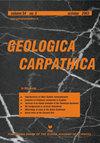东斯洛伐克盆地下巴登统沉积体系演化及其对储层岩石潜力的启示
IF 1.5
4区 地球科学
Q4 GEOSCIENCES, MULTIDISCIPLINARY
引用次数: 1
摘要
外喀尔巴阡盆地位于东喀尔巴阡山脉和西喀尔巴阡山脉的交界处,由Prešov和Trebišov两个子盆地组成。该盆地的油气勘探已经进行了60多年,具有重要经济意义的储量位于盆地的东至东北部分。通过对Trebišov次盆地的分析,对下巴登统(朗县)储层进行了表征和预测。为了实现这一目标,结合原始的总孔隙度和渗透率测量结果,进行了新的沉积相、地震相、岩石学和古生物学分析。根据浮游有孔虫和钙质纳米浮游生物的分带,将Trebišov次盆地的下巴登统层序划分为下段和上段。分选良好的砂岩层、海绿石颗粒、钠长岩、凝灰岩选择性蚀变为沸石以及化石组合的存在强化了火山影响的海洋环境。有记录的沉积构造表明,在新观察到的河流和三角洲相之前,存在水下密度流。砂岩总孔隙度测量结果表明,孔隙度随深度逐渐减小,地表为13.21%,地表以下~3 km处降至6.41%。这些数值对应于低孔隙度或低孔隙度的储层。成岩产物如伊利石、绿泥石和长石胶结、压实作用以及硅质胶结中结晶度的变化导致了初始孔隙度的改变。潜在的下巴登统储层砂岩经常受到走滑断层的变形,形成了大型拉分盆地复合体(在反射地震剖面上被视为马尾构造),形成了各种断界构造圈闭。在新合并的三维反射地震数据上,盆地中部两个反斜构造顶部的下巴登统砂岩显示出很强的反射振幅,突显了盆地的额外勘探潜力。本文章由计算机程序翻译,如有差异,请以英文原文为准。
Evolution of the lower Badenian depositional system in the East Slovakian Basin: Implications for reservoir rock potential
: The Transcarpathian Basin, consisting of the Prešov and Trebišov sub-basins, is situated at the border of the Western and Eastern Carpathians. Hydrocarbon exploration in this basin has been ongoing for more than 60 years and reserves of economic importance are located in the E to NE part of the basin. The Trebišov sub-basin was analysed to characterize and predict lower Badenian (Langhian) reservoir rocks. To achieve this aim, new sedimentary facies, seismic facies, petrographic and paleontological analyses were performed, combined with original total porosity and permeability measurements. Based on the planktic foraminifera and calcareous nannoplankton zonation, the lower Badenian sequence in the Trebišov sub-basin was divided into a lower and an upper interval. The presence of very well sorted sandstone layers, glauconite grains, albitization, selective alteration of tuffs into zeolites as well as the fossil assemblages reinforce the volcanic influenced marine environments. Documented sedimentary structures indicate subaqueous density flows preceded by the newly observed fluvial and deltaic facies. The total sandstone porosity measurements indicate a gradual porosity decrease with depth marked by a value of 13.21 % at the surface decreasing down to 6.41 % at ~3 km below the surface. These numbers correspond to reservoirs with low to reduced porosity. Diagenetic products such as illite, chlorite and feldspar cement together with compaction effects, and variations in the crystallinity in siliceous cement led to the modification of initial porosity. The potential lower Badenian reservoir sandstones are frequently deformed by strike-slip faults responsible for the large pull-apart basin complex (seen as horsetail structures on reflection seismic sections) forming various fault-bounded structural traps. The lower Badenian sandstones present at the top of two anti clinal structures in the central part of the basin, display very strong reflection amplitudes on newly merged 3D reflection seismic data underlining the additional exploration potential in the basin.
求助全文
通过发布文献求助,成功后即可免费获取论文全文。
去求助
来源期刊

Geologica Carpathica
地学-地球科学综合
CiteScore
2.40
自引率
23.10%
发文量
26
审稿时长
>12 weeks
期刊介绍:
GEOLOGICA CARPATHICA covers a wide spectrum of geological disciplines including geodynamics, tectonics and structural geology, volcanology, stratigraphy, geochronology and isotopic geology, karstology, geochemistry, mineralogy, petrology, lithology and sedimentology, paleogeography, paleoecology, paleobiology and paleontology, paleomagnetism, magnetostratigraphy and other branches of applied geophysics, economic and environmental geology, experimental and theoretical geoscientific studies. Geologica Carpathica , with its 60 year old tradition, presents high-quality research papers devoted to all aspects not only of the Alpine-Carpathian-Balkanian geoscience but also with adjacent regions originated from the Mediterranean Tethys and its continental foreland. Geologica Carpathica is an Official Journal of the Carpathian-Balkan Geological Association.
 求助内容:
求助内容: 应助结果提醒方式:
应助结果提醒方式:


